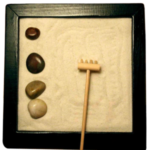Karensansui, or Japanese style in gardening, has been practiced for centuries but it came to be widely known only towards the end of the 6th century, with the help of Zen Buddhism. By the end of 1200, the basic principles of such gardens were established and since then they have gone through repeated levels of refinement and redimension. Gardens are called “kansho-niwa” or gardens for meditation, and the generic name is “Zen garden”. Consequently, any Japanese garden, smaller or larger, carries the name “Zen”.
One of the most intriguing aspects of a Zen garden, a Japanese garden in general, are the paper lanterns that can be found at every step.
Some of them were made to light the way through the garden, to reveal other entries in the smaller temples. Today, paper lanterns are a symbol of exceptional cultural heritage, used mainly to bring added effect to Japanese gardens. They deliver unexpected visual effects, depending on how they are designed and arranged.
Gardens made only from sand and stones are the favourite of the Japanese people, as well as their more advanced varieties which represent the Zen spirit.
Originally these gardens were places used by priests, for meditation, this is why is not surprising that such gardens can be found in Zen monasteries.
As the name suggests, this garden is composed only from rocks and sand, so if you want to have one made, given the fact that the materials are easily available, the investment will be minimum. It wouldn’t be bad if you could place some small walls around it, that you can do yourself, given the fact that it takes up a small area.
The number of stones that can be used is around 50, arranged in groups of four to five, placed all over the garden. You must use white sand and the stones will be arranged simply, but in an artistic manner, so that any onlooker is given the idea of space and nudity. The sand should basically clean the mind of the visitor, allowing him to make his own impressions about your garden. You should know that any change in the artistic arrangement of stones can affect it, so if you plan to install a new stone you should be careful at the relations among the existing ones, because, just as it can improve the situation, it may very well destroy the garden’s appearance and balance. All this leads to the idea that such a garden is a purely artistic representation of great talent, but done with a spirit involvement. Even if there seem to be too many rules, this can be easily overcome if you have some taste and a sense of balance.
As far as possible interpretations go, some people say that sand is suggestive of water and that stones are the islands that make up Japan.





